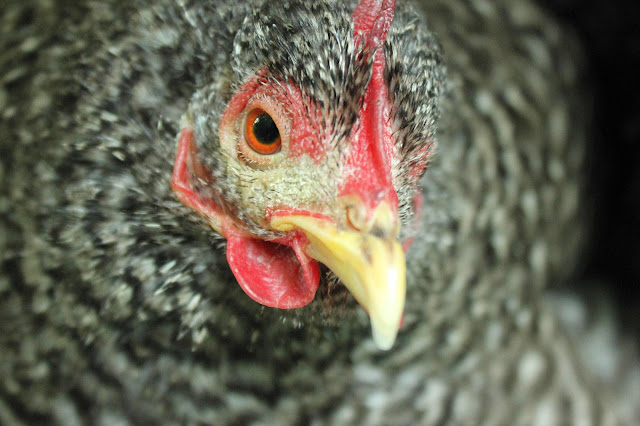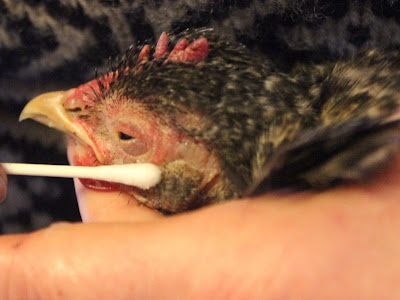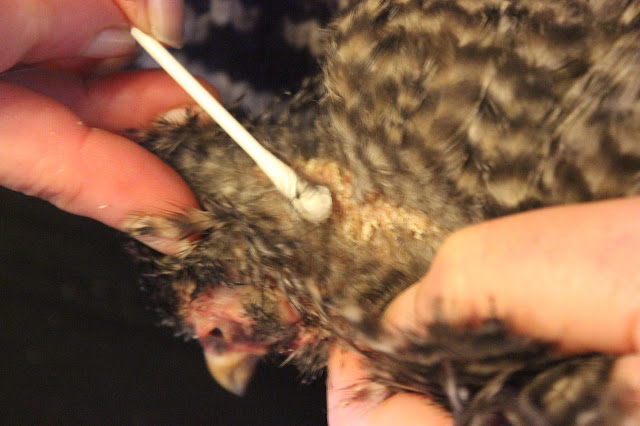There are already two previous parts to this article, one of which covers the identification and prevention of mite build-up, including crucial nutritional support and the other which deals with the treatment of scaly leg mite. If you are new to this subject and/or if you suspect your bird may have scaly face then it may be as well to go back and read these first as they both have bearing on the condition. You can find the links to these at the bottom of this page. That said here is the treatment I use for scaly face.
Above, Little Goldie, a Sebright/Polish Frizzle with a lovely personality and one of the few birds outside a couple of my Cochins with whom I have ever experienced scaly face. As you can see she is in new feather growth and I believe it is the abundance of keratin sheathing, aka mite food, around these new feathers, coupled with the fact that she has just been broody that engendered this condition. A broody hen tends to be a little erratic in both her feeding and grooming habits. Little Goldie, an omnivorous creature of great foraging ability and meticulous personal preening has been caught out. You can see evidence of the mite beneath her eye, around the corner of her beak and over her ear flaps. She will also have it no doubt at the back of her neck, another difficult place to groom and because of the difference in location of the mite, my treatment will vary accordingly.
Above is our very dear old cuckoo Cochin Pingu, she has had a recurring case of scaly face, although her scaly leg mite has now gone. However, as already discussed in the previous articles, these microscopic arachnids are so slow to accumulate in a volume large enough to be seen, that it is as well to err on the side of caution and carry on the treatment of the legs as long as the facial problem continues. I've also observed her scratching the back of her neck, so I will be focussing my treatment with her around that area. You can tell from her beak that as an old lady, who likes to take things easily, she's not as keen on foraging as she used to be but she eats well. It is most important with all health issues including parasite attack, that your bird eats apart from the rest of the flock. As in the case of Pingu here, I am then assured that she is getting a fair share of invertebrate protein, root vegetables and green leafy kale and also that she is not just filling herself up on, albeit sprouted, grain. As Pingu is also a sybarite and sun-worshipper, I'm pretty sure she's well topped up on her Vitamin D3, as she is now on her B complex vitamins, amino acids, Vitamins A, K and zinc.
This site is not called The Holistic Hen on a whim, I believe and hope I see all my poultry as individuals, thus it is not a foregone conclusion that all my Cochins, broodies or moulting Frizzles will have scaly face. Knowing the habits and personalities of my birds helps greatly in the prevention and cure of these conditions. Many parasitic and for example, respiratory problems need close contact to proliferate, so knowing who sits next to whom on the roost at night or how your poultry mix socially will help you to troubleshoot potential hosts. Both Badger (above) and Millefeuilles (below) are in the same coop as both Little Goldie and Pingu. At the present moment neither of the former are showing signs of scaly face nor scaly leg but as the Badger is sister and good companion to Pingu, I will be keeping my eye on her. Millefeuilles is pair-bonded to the coop's dominant cockerel Spike and also an inveterate forager, so I'm not so concerned about her. In an ideal world I would keep a book or spreadsheet on all these relationships and conditions but I usually rely on my memory and constant observation!
Think of Your Poultry as Individuals
This site is not called The Holistic Hen on a whim, I believe and hope I see all my poultry as individuals, thus it is not a foregone conclusion that all my Cochins, broodies or moulting Frizzles will have scaly face. Knowing the habits and personalities of my birds helps greatly in the prevention and cure of these conditions. Many parasitic and for example, respiratory problems need close contact to proliferate, so knowing who sits next to whom on the roost at night or how your poultry mix socially will help you to troubleshoot potential hosts. Both Badger (above) and Millefeuilles (below) are in the same coop as both Little Goldie and Pingu. At the present moment neither of the former are showing signs of scaly face nor scaly leg but as the Badger is sister and good companion to Pingu, I will be keeping my eye on her. Millefeuilles is pair-bonded to the coop's dominant cockerel Spike and also an inveterate forager, so I'm not so concerned about her. In an ideal world I would keep a book or spreadsheet on all these relationships and conditions but I usually rely on my memory and constant observation!
Raw Virgin Coconut Oil
If you haven't this miraculous substance already in your pantry then I advise you to get some, both for your own and your poultry's health. Applied externally, this oil particularly comes into its own when the areas you are treating include those around which essential oils should not be used because they are so sensitive. Organic raw pure virgin coconut oil is a magical substance, which contains
lauric, capric and caprylic acids, these have wide ranging properties,
such as antimicrobial, antioxidant, anti-fungal,
antibacterial and soothing qualities. Coconut oil is a great support for the immune system and has both healing properties for the skin and promotes the regrowth of feathers/hair. We use it in cooking as well as in making cosmetics. Although a saturated fat coconut oil is made up of two thirds medium-chain fats aka medium-chain triglycerides or MCTs, these are metabolised in a completely different way to most fats, in that they do not need bile or digestive enzymes. Thus, when used internally, MCTs in coconut oil are readily available for use by both the body and the brain and not stored as in the usual way of fats. In the case of a stressed, tired bird or one lacking in energy due to mite activity, this is an assured way of giving a great boost to both motor and nervous system function. So when I treat externally with coconut oil, I always make sure the bird gets a nice nugget of coconut oil to eat as well - my birds love it!
Lauric acid makes up about half of the fatty acids in coconut oil. When lauric acid is digested, it transforms into a monoglyceride called monolaurin. Both lauric acid and monolaurin aid in ridding the gut of harmful pathogens such as bacteria, viruses, fungi and parasites. This, as we have already discussed in the previous articles on this subject, is a bonus in the case of external mites, where continued activity can have compromised the gut and thus the immune system and digestive processes. So even if your bird is now eating well it may still not be able to extract the nutrients from its food. Coconut oil therefore is a most important asset to your medicine chest.
In the sensitive areas around the eyes, beak, nose and ear flaps, I only use pure coconut oil and as always, to apply it I'm using organic cotton buds. Be generous in your use of these, as with all microscopic creatures, it is easy for some of them to avoid direct contact with the treatment. As you apply the coconut oil, layers of these creatures and their debris will be removed, so to avoid any being reapplied and surviving, change the cotton bud often as practical. It is also possible as you get nearer to the skin that you will remove creatures that are burrowed below the surface, this may cause redness and in fact some slight bleeding. Stop the 'cleaning' treatment of these areas at this point and just gently pat on some coconut oil. This will both aid in skin repair and stop, by the antimicrobial effect of the coconut oil, any potential infection.
Why the Need for Essential Oils?
You might think that killing the mites by suffocation, i.e preventing them from accessing oxygen through breathing tubes or rudimentary lungs by blocking them with oil would be sufficient. However, when I first had to deal with external parasites many years ago, I read a lab report in which it was documented that arthropods treated solely with a carrier oil had in fact
been able to 'hold their breath' for more than an hour. Thus their
breathing apparatus had had time to absorb the oil, become unblocked and therefore the mites had
been able to survive the treatment. Thus the addition of an essential
oil with insecticidal properties is necessary to be sure of ridding them
from the host.
Essential Oil - Tea Tree (Melaleuca alternifolia)
Tea tree essential oil amongst its many properties is an insecticide and is used in organic farming as such. In fact it was a farmer friend of mine, who shadowed an organic vet as part of her continuing education, who first recommended tea tree to me as a cure for scaly leg many years ago. Tea tree also has wound healing properties, as does the coconut oil and as these mites can cause skin lesions, this is a very welcome extra virtue.
At the back of the neck, around the top of the head or to treat any other area away from the ear, eye, nose or beak, I add one drop of tea tree essential oil to a teaspoonful of melted (carrier) coconut oil. This is the amount for each bird to be treated. Thus, if I have a very large area to treat and run out of the essential oil/carrier oil mixture, I revert back to just using the pure coconut oil. The are several reasons why I only like to use 1 drop of tea tree when treating scaly face. The first being because tea tree is a strong oil and I don't like to use too much on the skin (unless as with my pigeon, in an earlier article, this is a case of gangrene or infection). Secondly because one of the greatest receptors for essential oil is through the lungs, so as I'm treating the bird in areas in close proximity to its nose, I keep the dose to a minimum of one drop per day.
At the back of the neck, around the top of the head or to treat any other area away from the ear, eye, nose or beak, I add one drop of tea tree essential oil to a teaspoonful of melted (carrier) coconut oil. This is the amount for each bird to be treated. Thus, if I have a very large area to treat and run out of the essential oil/carrier oil mixture, I revert back to just using the pure coconut oil. The are several reasons why I only like to use 1 drop of tea tree when treating scaly face. The first being because tea tree is a strong oil and I don't like to use too much on the skin (unless as with my pigeon, in an earlier article, this is a case of gangrene or infection). Secondly because one of the greatest receptors for essential oil is through the lungs, so as I'm treating the bird in areas in close proximity to its nose, I keep the dose to a minimum of one drop per day.
Essential oils are quick acting and should only be used for a
short period, I work on a schedule of five days of treatment and then five days with
no treatment before starting again, I have rarely ever got past the
first five days. The ailment has either cleared up or I have realised I
had made the wrong diagnosis and switched treatments.
Above All Communicate
Your bird will be very grateful to you for solving this problem as parasites are, I imagine, a horrible thing to endure. However, your chicken may not enjoy being treated for them, despite having a piece of yummy coconut oil to eat. Talk to your birds throughout the treatment, reassuring them by the tone of your voice that all is well. If you have noticed the similarities between human and chicken-speak, then you will already understand that tone and cadence are all important. Your chicken will instinctively know what you are saying.
Below is Snowman, a White Columbian Cochin, he was never a very domesticated creature until one day, on a rare occasion he let me pick him up, I felt the tell-tale excrescences of scaly mite on his feet. Post treatment, he began to follow me about in the garden and continued to do so just like a puppy. We became the best of friends, my only regret being I hadn't forcibly inspected those large fluffy/feathery feet much earlier and thus prevented him any distress. However, his continued affection led me to believe that he had forgiven me.
Hope this was of help and please feel free to share this article and or ask questions or add your experiences with this condition. If you are interested you can also visit our Patreon site, where you can learn what other projects we have in store. In the meantime until the next article,
Sue
RELATED ARTICLES
Scaly Leg and Face Mite Infestations Why They Happen & What To Do Part1
I look at the correlation between specific
deficiency and parasitisation because it is fundamental to everything I
believe is wrong...read more
Scaly Leg Mite Infestations What To Do Part 2
I look at the options both medicinal and nutritional for dealing with this microscopic mite ...read more
 Stress - When? Why? Whom? Identification, causes and those most at risk
Stress - When? Why? Whom? Identification, causes and those most at risk
 Stress
comes for all sorts of reasons to an organic flock and if not treated
within 24 hours, if it's a bad attack, it can be fatal...read more
Stress
comes for all sorts of reasons to an organic flock and if not treated
within 24 hours, if it's a bad attack, it can be fatal...read moreCommon Poultry Lice identification, life cycle and major infestation periods
Menacanthus
stramineusare ectoparasites, thus living on the skin...with a short
life span, which in adult form, is from 2 to 3 weeks read more
Common Poultry Lice - Treatment and Prevention
When
you apply any sort of viscous carrier oil to a louse, the spiracles,
pores through which it breathes, become blocked, however, read more
Ticks - Identification, life cycle and lifestyle
I
have to say right from the start the more I read about ticks the more
confused I get. There is a volume of information floating about...read more
Ticks Treatment and Removal from a pigeon's face
Essential oil of Tea Tree has
the properties of an anaesthetic, antibacterial, antiviral, antiseptic
and antimicrobial...read more
RETURN TO CONTENTS PAGE
© 2018 Sue Cross
Comprehensive Guide to Red Mite Identification & Assessment Part 1
In the following two part articles I set out the information I used and protocols I created from reading through the available research...read moreRed Mite Part 2 Prevention & 3 Cures: Essential Oil, Fire, Steam
Because I have access to all three Fire, Steam and Essential Oils, I
like to use a combination of all three but any one of them used alone ...read more
If I could talk to the (animals) birds Part 1
Looking
at the history and research behind bird communication, marking the
start of a series of articles sharing ideas on how talking helps...read more
RETURN TO CONTENTS PAGE
© 2018 Sue Cross















